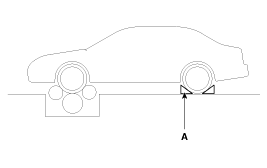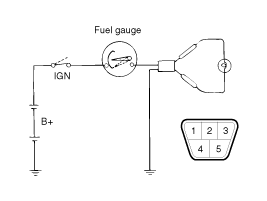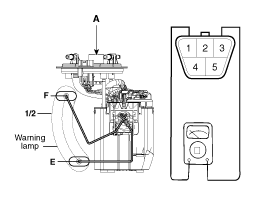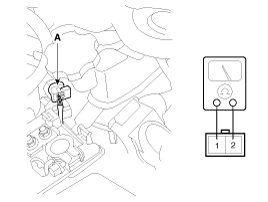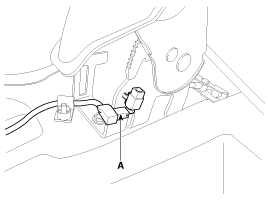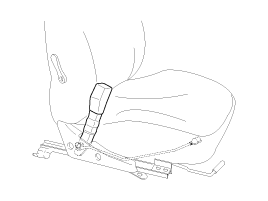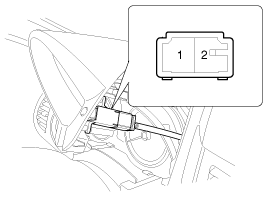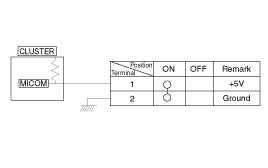 Kia Rio: Instrument Cluster Inspection
Kia Rio: Instrument Cluster Inspection
Speedometer
| 1. |
Adjust the pressure of the tires to the specified level.
|
| 2. |
Drive the vehicle onto a speedometer tester. Use wheel chocks
(A) as appropriate.
|
| 3. |
Check if the speedometer indicator range is within the standard
values.
[km/h]
[MPH]
|
Tachometer
| 1. |
Connect the GDS to the diagnostic link connector or install a
tachometer.
|
| 2. |
With the engine started, compare the readings of the tester with
that of the tachometer. Replace the tachometer if the tolerance is exceeded.
|
Fuel Gauge
| 1. |
Disconnect the fuel sender connector from the fuel sender.
|
| 2. |
Connect a 3.4 watt, 12V test bulb to terminals 1 and 3 on the
wire harness side connector.
|
| 3. |
Turn the ignition switch to the ON, and then check that the bulb
lights up and the fuel gauge needle moves to full.
|
Main Fuel Gauge Sender
| 1. |
Using an ohmmeter, measure the resistance between terminals 1
and 3 of sender connector (A) at each float level.
|
| 2. |
Also check that the resistance changes smoothly when the float
is moved from "E" to "F".
|
| 3. |
If the height resistance is unsatisfied, replace the fuel sender
as an assembly.
|
Brake Fluid Level Warning Switch
| 1. |
Remove the connector (A) from the switch located at the brake
fluid reservoir.
|
| 2. |
Verify that continuity exists between switch terminals 1 and 2
while pressing the switch (float) down with a rod.
|
Brake Fluid Level Warning Lamp
| 1. |
Ignition "ON"
|
| 2. |
Release the parking brake.
|
| 3. |
Remove the connector from the brake fluid level warning switch.
|
| 4. |
Ground the connector at the harness side.
|
| 5. |
Verify that the warning lamp lights.
|
Parking Brake Switch
The parking brake switch (A) is a pulling type. It is located under the
parking brake lever. To adjust, move the switch mount up and down with the parking
brake lever released all the way.
| 1. |
Check that there is continuity between the terminal and switch
body with the switch ON (Lever is pulled).
|
| 2. |
Check that there is no continuity between the terminal and switch
body with the switch OFF (Lever is released).
If continuity is not as specified, replace the switch or inspect
its ground connection.
|
Door Switch
Remove the door switch and check for continuity between the terminals.
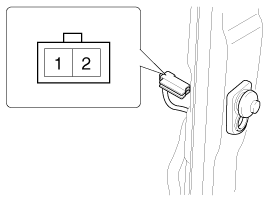

Seat Belt Switch
| 1. |
Remove the connector from the switch.
|
| 2. |
Check for continuity between terminals.
|
Seat Belt Warning Lamp
With the ignition switch turned ON, verify that the lamp glows.
| Seat belt condition |
Warning lamp |
| Fastened |
OFF |
| Not fastened |
ON |
Trip Switch
| 1. |
Disconnect the negative (-) battery terminal.
|
| 2. |
Remove the trip switch (A) from the cluster fascia panel.
|
| 3. |
Check for continuity between the terminals in each switch position
according to the table.
|
 Instrument Cluster Circuit Diagram
Instrument Cluster Circuit Diagram
[Standard]
[Supervision]
...
 Instrument Cluster Removal
Instrument Cluster Removal
1.
Disconnect the negative (-) battery terminal.
2.
Using a screwdriver or romover, remove the cluster fascia panel
(A).
...
See also:
Installation
1.
Install in the reverse order of removal.
2.
Adjust the alternator belt tension after installation.
(Refer to Engine charging Sy ...
Special Service Tools
Tool
(Number and Name)
Illustration
Use
09200-38001,3N000 (Beam)
09200-1P100, 4X000 (Adapter)
09200-2S200 (Supporter)
Engine support assembly
...
Blower Unit Replacement
1.
Remove the heater & blower unit.
(Refer to HA group - "Heater Unit")
2.
Separate the blower unit from the heater unit a ...
Copyright ® www.kirmanual.com 2014-2025



